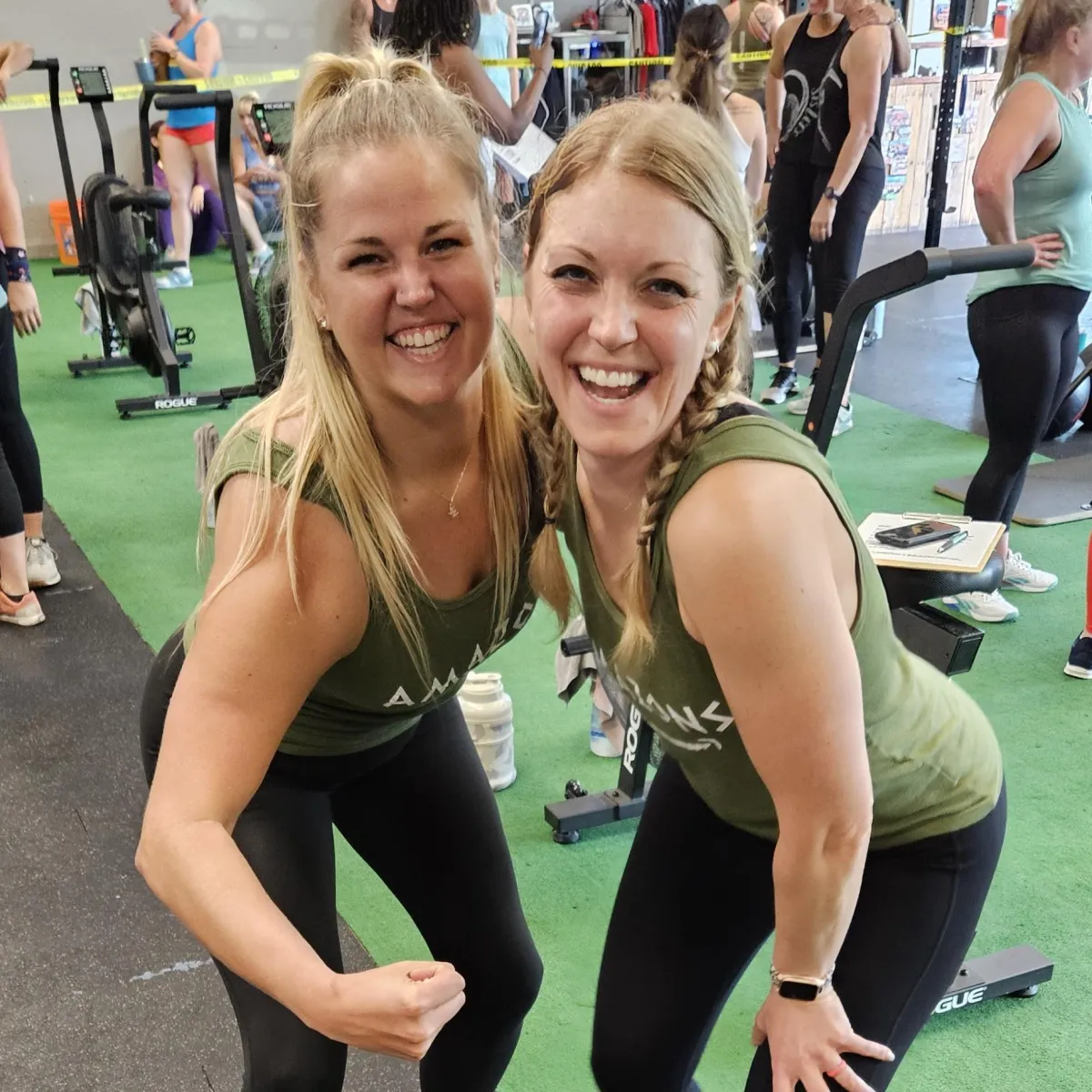WEIGHT LOSS & FITNESS BLOG

What the Dysfunction?
Let’s talk about core strength. Now when people think of the core, they think about a ripped six pack. While a million crunches and sit-ups MIGHT get you those washboard abs, having a strong core is so much more than having chiseled muscles.
I like to think of the core as a box. It has a front (Rectus abdominis aka the abs), the back (multifidus which stabilizes the spine and connects to the pelvic floor), the sides (transverse abdominis), top (diaphragm) and the bottom (pelvic floor.) While there are others that play a supporting role in core function, these are what I feel are most important in overall core function and strength.
So now that we’ve had a little anatomy lesson, let’s dive into why it’s so freaking important.
Raise your hand if you've heard the phrase “core dysfunction.” I’m sure you have at some point or another but often it’s associated with women who are pregnant or postpartum. Diastasis recti (separation of the rectus abdominis) being the most common one. Pelvic floor dysfunction is another common term for women who have the urge to pee every time they jump or even cough. Pelvic floor dysfunction also refers to women who suffer from organ prolapse of some kind.
Side note: remember what we just learned about the core? The pelvic floor is a part of the core as a whole unit, so when referring to core dysfunction, remember that pelvic floor dysfunction is included in that term.
So, it seems like core dysfunction most commonly occurs in women, right? WRONG.
It just presents differently for men. And to understand that better, let’s look at the anatomy and men and women. (Nothing X-rated, I promise!)
You can see in the image that the female pelvis is much wider, meaning female organs are being held up mostly by muscle, whereas for men, they are supported with more bone. This explains why postpartum women are often peeing themselves and struggle to reconnect with their pelvic floor. Things get stretched out, you go through something very traumatic, and then we forget how to use muscles we never used to have to think about before. Even women who don’t have children can eventually suffer from incontinence. 1 out of every 4 women will suffer from some form of pelvic floor dysfunction. Sucks to be female, right?
Well get this: 1 in 4 men will suffer from a hernia at some point in their life. And what causes hernias? Lifting heavy objects without properly bracing your core (aka CORE DYSFUNCTION). So, men may not be peeing themselves all the time, but surely there is something dysfunctional about their core with statistics that high. But we as a society have accepted it as normal. Mom can't jump on the trampoline. Normal. Dad has a bad back and two hernia surgeries. Typical for his age.
I say TO HELL WITH THAT IDEOLOGY.
I could write forever about how to properly brace and exercise your core to help it be both strong and functional, but let’s face it, neither you nor I have that kind of time. SO, I’m just going to cover the basics here:
How to tell if you are engaging properly
And if you’re not, how to do it properly
So, let’s get to it.
How to tell if you are properly engaging:
Whether you have had kids or not, this will apply to you. Now there are two things we look for for improper engagement. One is coning and one is called doming. Coning refers to when the space between each side of your rectus abdominis cannot regulate your intra-abdominal pressure, and it pops up looking like a mountain ridge all the way down your stomach. Like the Toblerone chocolate bar.
Doming is when your abs are contracted and looks like a bread loaf. Probably the more commonly seen form of core dysfunction. Looks more like this where you can see the dips on either side of the ab muscles.
You might look at the doming picture and wonder why that’s bad. And truth is most people look like this when they do ab work like leg lowers, hollow body hold, or any back work really. The problem is the TVA is not active here. You can see the big dips near her hips and if you were to press them, they would be soft, not hard the way an engaged muscle should be. Try it on yourself! Lay down, crunch up, and if you see those dips by your hip bones, press them. Are they firm? Probably not.
Why is the transverse abdominis (TVA) so important? Let’s look at where it connects.
The TVA literally wraps around the entire body, but most importantly, goes all the way down to the pubic bone. Where do most hernias occur? Yep, right down there along the hips and groin area where your TVA connects. Being able to engage and strengthen your TVA means a better chance of preventing hernias! And if you are strengthening your core, guess what else happens? PR’s, baby! Stronger more confident lifts!
A strong TVA will also help with that urge to pee! Why? It works in conjunction with your pelvic floor muscles! I’m sure you have been told a million times to do kegels to help with incontinence. I think of kegels like someone telling you to flex your bicep while keeping your arm straight. Sure, you can do it, but that is not the position that the bicep is at its strongest. You would never try to strengthen your biceps with a straight arm, right? The same goes for your pelvic floor. You can “strengthen” it with kegels, sure, but what it’s really meant to do is lift.
So how do we fix it?
How to Properly Engage
Start by taking a big diaphragmatic breath. Wait, what does that mean?
Place your hands around your ribcage like in the first picture.
Take a big inhale the nose focusing on expanding through the ribcage not the stomach. Imagine you have cups in your hands, and you are trying to fill them with your inhale.
Exhale through the mouth with your tongue making an "S" noise. Focus on your core pulling together like a corset while also lifting the pelvic floor. Remember to sit up nice and tall.
Congrats! Your first diaphragmatic breath!
You can practice this breath work by doing the full breath cycle and focusing on longer holds after the exhale. You can continue to breathe through your chest but focus on holding that engagement in the core and pelvic floor for maybe 3 sets of 5 to 10 second holds.
Now let’s apply this to core work. Try that same breath work lying down on the floor on your back. Inhale. And exhale with that "S" breathe, contracting the core and lifting the pelvic floor. Hold it while breathing through your nose and crunch up. If you are engaging properly, your abs should look nice and flat! No soft spots or bulging spots. You’ll probably find that it’s hard to maintain those flat abs for long. Why? Because you’re not used to it. Your TVA isn’t used to being engaged so it will take time for it to catch up. So, give it time and lots of practice! And modify the ab work we do at BFP until you can hold for longer periods of time. Keep a hand on your tummy to check your engagement and if you find yourself failing. Reset with that breath and keep going...
The great thing about this diaphragmatic breath is you can do it anywhere! On your commute to and from work, laying bed or on the couch watching Netflix, relaxing on the beach. Practice from all angles: on your back, on hands and knees, in a modified side plank, and or course sitting and standing.
The core muscles enable us to breathe, establish posture, and transfer energy. Your core can be seen as the “athletic” driver in your body. Your limbs attach onto your core and your core allows you to move and have mobility whether you are playing sports, working out or being active. A strong core entails great control in your abdomen, pelvis, and hip regions.
When you retrain your mind to be aware of your body and how to handle intra-abdominal pressure, the benefits are phenomenal. If these techniques are done properly, your core will be exhausted. I felt as if I got a much better workout utilizing these techniques while pregnant than I did doing complicated core workouts prior to pregnancy. It also enabled my core to respond faster postpartum.
To that point, before doing any true abdominal work or intense core exercises, take a step back and establish the foundations needed to be successful. Once you are confident in your core activation, then you can start integrating these core activation techniques into your workout regimens and more intense ab work. You will eventually find what works for you. Will you deliberately have to engage your core every rep for the rest of your life? NO. You will learn when you need to apply correct core engagement to your workouts to control intra-abdominal pressure and protect your core over time and to get there, repetition is going to be your best friend.


Are you Ready to become
sTRONG - FIT - cONFIDENT?
Click the Button To Start Your Journey Today!!

